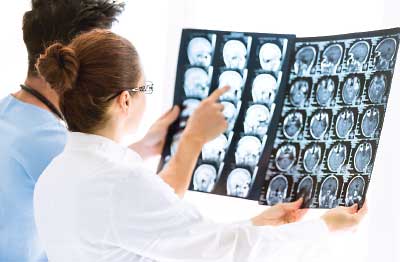Centuries ago, some doctors proposed that the shape and feel of a person’s skull could provide insight into his or her character—a study known as phrenology. Although phrenology has since been discredited by scientific research, modern neuroimaging has shown that the topography of the human brain is associated with some behavioral traits.
A study published in JAMA Psychiatry in late April is one of the latest pieces of evidence of the association between the physical structure of the brain and behavioral outcomes. The study showed that transition to psychosis is associated with perturbed gyrification—the coordinated process of forming the folds of the cerebral cortex during development that creates the distinct wrinkled appearance of the brains of humans and other mammals. By using MRI to examine gyrification patterns, clinicians may be better able to predict individuals at high risk for psychosis who are most likely to develop psychosis.
This discovery came from an analysis of over 160 MRI scans from individuals with or without psychosis conducted by researchers from the University of Basel in Switzerland and the University of Western Ontario in London. The scans included 63 people who were at risk of psychosis but who did not subsequently develop any disorder, 16 people who were at risk of psychosis and later developed psychosis, 38 people who had experienced a first-episode psychosis and were antipsychotic free, and 44 healthy controls.
The investigators found that the gyrification patterns of the at-risk individuals who later developed psychosis were more disorganized than either the healthy controls or at-risk nonconverters; in fact, the brain scans of future converters closely resembled those of people with existing psychosis.
Study co-author Lena Palaniyappan, M.D., an associate professor of psychiatry and neuroscience at Western Ontario, explained to Psychiatric News that gyrification is highly coordinated during development, and brain regions with similar folding patterns tend to fold at the same time, even if they are not physically close together.
“In those who transition [to psychosis], these coupling patterns are highly likely among neighboring regions, but less likely among distant regions,” he said.
The investigators developed an algorithm based on the observed differences in gyrification patterns in their sample and found it could differentiate between those who went on to develop psychosis and those who did not with about 80 percent accuracy. The ability of the algorithm to weed out people not at risk of psychosis (false positives) was well over 90 percent. The algorithm failed to identify about 1 in 3 at-risk individuals who converted to psychosis.
“If we can further increase sensitivity and keep false negatives to a minimum, our procedure would … help clinicians know who might benefit from a preventive intervention,” said senior study author Andrȳ Schmidt, Ph.D., of the University of Basel.
The scanning procedure itself only takes about 10 minutes since it only requires structural maps, so patient burden is minimal.
Schmidt told Psychiatric News that running the gyrification mapping algorithm takes about 10 hours for each patient, but it is an automated procedure that can be done with technology platforms readily available at most neurological clinics. His team is working on a software program that will let clinicians easily run the prediction tool from their existing computers.
One advantage of the gyrification-based biomarkers is that they are more consistent over time than blood-based and brain activity–based biomarkers, which often fluctuate day to day and hour to hour, respectively. Because gyrification begins in fetal development and the folding patterns are established by 2 years of age, it is also possible that people may show disorganized gyrification many years before any psychosis symptoms develop, allowing for earlier interventions. Even the best current identification techniques are sensitive enough to identify only those people who may be a year or two from developing first-episode psychosis.
If the researchers improve the sensitivity of the gyrification algorithm, Schmidt said it could be used “to supplement clinical assessments. The idea is to stratify at-risk individuals into risk classes, which help to tailor individual treatment and prevention strategies.”
Tyrone Cannon, Ph.D., a professor of psychology and psychiatry at Yale University, who was not involved with the study, said the findings were intriguing, but noted the jury is still out on how the algorithm will perform. “These investigators used a technique to discover a pattern [of gyrification] within their own sample only, and such programs can find patterns even by chance,” he said. “They need to better clarify the biomarker, as the exact components of this gyrification index are still a little ambiguous.”
If these gyrification patterns hold up after independent samples of MRI scans are tested, however, Cannon agreed it could be a promising tool to use when assessing patients who may be at risk of psychosis.
This study was supported by grants from the Universitäre Psychiatrische Kliniken in Basel and Canadian Institutes of Health Research, with additional support from the Bucke Family Fund, Chrysalis Foundation Fund, and Opportunities Fund from the Academic Medical Association of South Western Ontario. ■
“Disorganized Gyrification Network Properties During the Transition to Psychosis” can be accessed
here.

